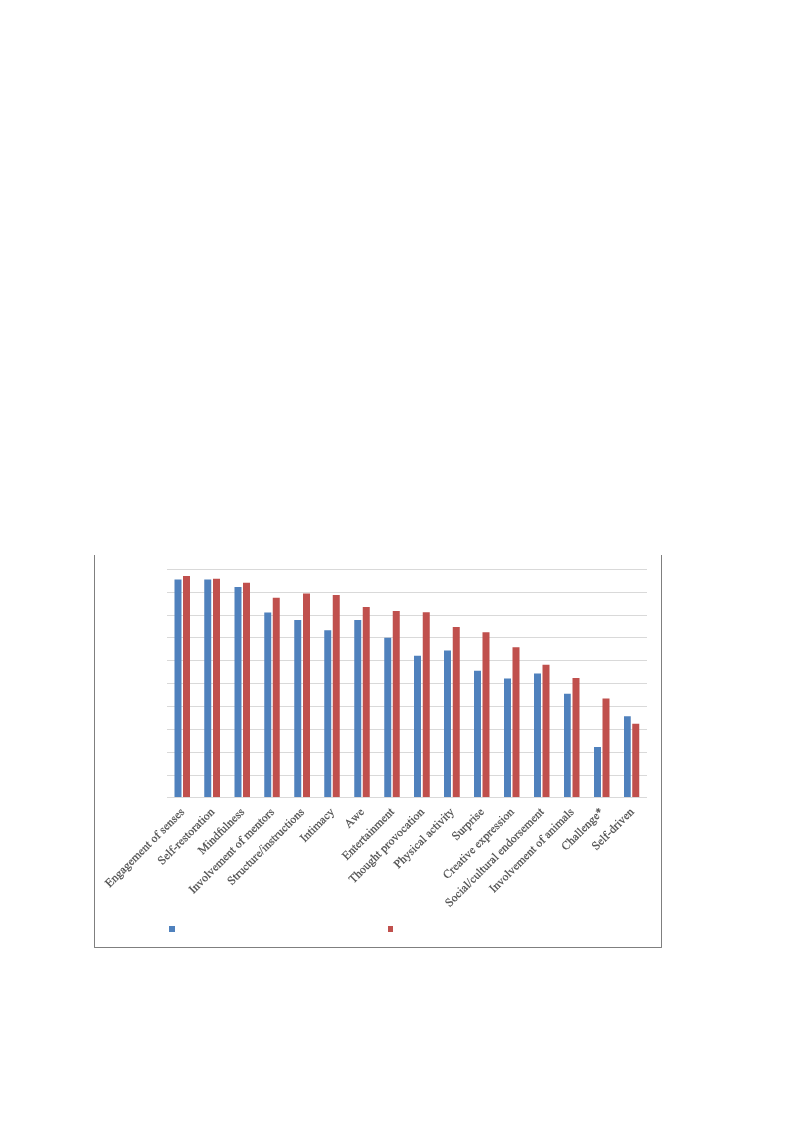
Stockholm Resilience Centre
Sustainability Science for Biosphere Stewardship
Master’s Thesis, 60 ECTS
Social-ecological Resilience for Sustainable Development
Master’s programme 2019/21, 120 ECTS
Coming back to our senses:
Exploring the potential of guided forest bathing
as an intervention for human-nature connection
Annelie Vårhammar

“The land is the real teacher. All we need as students is mindfulness.
Paying attention is a form of reciprocity with the living world,
receiving the gifts with open eyes and open heart.”
― Robin Wall Kimmerer
2

ABSTRACT
Fostering human-nature connection (HNC) relates to the inner worlds of humans as a realm of
influence for sustainability and is considered a deep leverage point for system transformation.
Both direct nature experiences and states of mindfulness are significant for influencing the
development of HNC. Therefore, in this thesis, I explore the potential of guided forest bathing
– an originally Japanese practice of mindfully immersing one’s senses in the atmosphere of a
forest – as an intervention for HNC. I do so by applying a mixed methods approach and a
relational, multidimensional assessment of the qualities and effects of a guided forest bathing
session, as conducted in the methodology of the Scandinavian Nature and Forest Therapy
Institute. While not able to establish causality, the study results suggest that participation in
just one guided forest bathing session may positively influence the development of HNC,
primarily in participants new to the experience. The results also suggest that several qualities
of guided forest bating are important for influencing HNC, including mindfulness,
engagement of senses, and self-restoration. These qualities and others related to the specific
structure and social setting of the experience can provoke thoughts that meaningfully shift
how individuals perceive and interact with nature. This leads the thesis to conclude that
guided forest bathing represents a novel nature experience with promising potential as an
intervention for HNC.
Keywords:
Human-nature connection, guided forest bathing, assessment, mindfulness in nature,
interventions, sustainability transformation, deep leverage point
Main thesis supervisor:
Matteo Giusti, Gävle University
Thesis co-supervisors:
Vanessa Masterson, Stockholm Resilience Center,
Petra Ellora Cau Wetterholm, Scandinavian Nature and Forest Therapy
3

ACKNOWLEDGEMENTS
I wish to express huge gratitude to all the study participants who answered the two online
surveys and especially to those who took the time to be interviewed. Your eloquent, rich
responses to my interview questions and your admirable openness about your thoughts and
experiences are what gave additional life and richness to this thesis.
Many persons contributed greatly to making this thesis project possible. A massive thanks to
my external supervisor and collaborator Petra Ellora Cau Wetterholm for the support, long
discussions and for granting me access to the SNFTI methodology, internal network of
guides, and your immense wisdom about guided forest bathing. A particular thank you to the
ten amazing forest bathing guides who joined the study and made data collection possible:
o Petra Ellora Cau Wetterholm, Scandinavian Nature & Forest Therapy Institute and
Shinrin-Yoku Sweden, https://www.scandinaviannatureandforesttherapyinstitute.com/
o Annette Öhrn, SaktaIn, http://www.saktain.se
o Kerstin Ulbing Ponnert, Shinrin-Yoku Lund/Ängelholm
o Kristina Olsson, Gröna samtal, http://gronasamtal.se/
o Lotta Ihse, Urban Balance club, http://www.urbanbalanceclub.se
o Margit Melin, Melins Ord, http://www.melinsord.se
o Maria Moody Källberg, Nätverkskompaniet MMK AB Skogsvaro,
https://natverkskompaniet.se/skogsvaro/
o Marie Rosén, NaturStark AB, https://www.naturstark.se/
o Peter Amling, MindChange, https://www.facebook.com/mindchangesweden/
o Susanna Bävertoft, True by You, https://truebyyou.se/
Of course, a warm thank you to my supervisors Matteo Giusti at Gävle University and
Vanessa Masterson at Stockholm Resilience Center for believing in me and this thesis idea.
You both provided invaluable feedback and support, particularly when we were faced with
having to pause the thesis due to the COVID-19 pandemic and then quickly recoup a few
months later. Last but not least, I want to say thank you to my thesis group classmates for the
feedback and encouragement in the writing process, and to my beloved friends and family for
cheering me on.
4

TABLE OF CONTENTS
1. INTRODUCTION ........................................................................................................................... 8
1.1. Research questions ................................................................................................................ 10
2. THEORETICAL FRAMEWORK................................................................................................. 11
2.1. Human-Nature Connection (HNC)........................................................................................ 11
2.1.1. ACHUNAS – An embodied approach to human-nature connection............................. 11
2.1.2. New Ecological Paradigm (NEP) .................................................................................. 12
2.2. Mindfulness and sustainability .............................................................................................. 13
2.2.1. Mindfulness and HNC ................................................................................................... 14
2.2.2. Mindfulness in nature and HNC .................................................................................... 14
2.3. Forest Bathing ....................................................................................................................... 15
2.3.1. Origin............................................................................................................................. 15
2.3.2. Guided forest bathing in the West ................................................................................. 15
2.3.3. Guided forest bathing and mindfulness ......................................................................... 16
2.3.4. Guided forest bathing and HNC .................................................................................... 16
3. METHODOLOGY ........................................................................................................................ 18
3.1. Ontological position .............................................................................................................. 18
3.2. Mixed-methods research design ............................................................................................ 18
3.3. Guided forest bathing sessions .............................................................................................. 18
3.4. Quantitative surveys .............................................................................................................. 20
3.4.1. Participant selection method.......................................................................................... 20
3.4.2. Data collection procedure.............................................................................................. 20
3.4.3. Survey measures ............................................................................................................ 21
3.4.4. Quantitative data analysis.............................................................................................. 23
3.5. Qualitative semi-structured interviews.................................................................................. 23
3.5.1. Sampling and data collection procedure........................................................................ 23
3.5.2. Qualitative analysis strategy .......................................................................................... 23
4. RESULTS...................................................................................................................................... 25
4.1. Descriptive and statistical survey results............................................................................... 25
4.1.1. Sample description ........................................................................................................ 25
4.1.2. Validity and reliability of ACHUNAS .......................................................................... 25
4.1.3. HNC scores.................................................................................................................... 25
4.1.4. NEP scores .................................................................................................................... 26
4.1.5. Qualities of SNS ............................................................................................................ 26
4.2. Explanatory insights from interviews.................................................................................... 27
4.2.1. Guided forest bathing as significant nature situation .................................................... 27
4.2.2. Thought provocations .................................................................................................... 30
5

4.2.3. Negative aspects ............................................................................................................ 34
5. DISCUSSION ............................................................................................................................... 36
5.1. Effect of guided forest bathing on HNC................................................................................ 36
5.2. Qualities of guided forest bathing influencing HNC ............................................................. 37
5.3. Assessing the influence of nature experiences ...................................................................... 38
5.4. Methodological reflections and future directions .................................................................. 38
5.5. Implications of study ............................................................................................................. 39
6. CONCLUSIONS ........................................................................................................................... 41
7. REFERENCES .............................................................................................................................. 42
8. APPENDICIES ............................................................................................................................. 46
8.1. Appendix 1: Plain language statement .................................................................................. 46
8.2. Appendix 2: Consent form .................................................................................................... 47
8.3. Appendix 3: Interview guide ................................................................................................. 48
8.4. Appendix 4: Summary of subthemes for each quality of SNS .............................................. 49
8.5. Appendix 5: Note on methodology ....................................................................................... 53
8.6. Appendix 6: Ethical review – final review............................................................................ 54
6

LIST OF TABLES & FIGURES
TABLE 1 | The 16 qualities of significant nature situations in the ACHUNAS………………………12
TABLE 2 | The ten abilities of human-nature connection in the ACHUNAS………………………...13
TABLE 3 | Names and descriptions of the nine forest locations………………………………………10
TABLE 4 | The survey items used for the ten abilities of human-nature connection………………….21
TABLE 5 | The 8-item version of the New Ecological Paradigm Scale………………………………21
TABLE 6 | The survey items used for the 16 qualities of significant nature situations……………….22
TABLE 7 | Summary of the six themes for the quality thought provocation………………………….31
TABLE 8 | Summary of themes for the category “negative aspects”…………………………………35
FIGURE 1 | Illustration of the sequential mixed methods research design……………………………18
FIGURE 2 | Map of southern Sweden showing the nine forest locations……………………………..19
FIGURE 3 | Graph of the results for the 16 qualities of significant nature situations…………………26
ACRONYMS
ACHUNAS – Assessment framework for Children’s Human Nature Situations
HNC – Human-Nature Connection
SNS – Significant Nature Situation
NEP – New Environmental Paradigm
SNFTI – Scandinavian Nature and Forest Therapy Institute
Word count: 9 948 words
(Including footnotes, excluding tables, figures, and appendices)
7

1. INTRODUCTION
Humanity is facing great social and environmental challenges. These challenges are part of
the same social-ecological system that has kept us on a trajectory of unsustainability during
the past decades (Steffen et al. 2011). A commonly argued cause of today’s unsustainability is
the dominant Western paradigm of anthropocentrism – a human-centered environmental ethic
and worldview of separation that places only instrumental value on nature1 (Katz 1999). This
way of thinking has been suggested as a driver for the current economic growth model that
frames negative environmental impacts as externalities and nature as solely a never-ending
resource from which to exploit and profit (Katz 1999; Strang 2017). Scholars suggest that the
cognitive disconnection and lack of understanding of the interdependence between humans
and nature is not just a cause of unsustainability but a symptom of the larger changes in
society (Seppelt & Cumming 2016; Pyle 2003), such as urbanization (Cumming et al. 2014;
Giusti 2019) and a general “extinction” of direct nature experiences (Soga & Gaston 2016;
Giusti et al. 2014).
The call for humanity to “reconnect with nature” is growing stronger among both citizens and
scholars (e.g. Folke et al. 2011; Zylstra et al. 2014). Reconnecting with nature is about
shifting the relationship between humans and the rest of nature. It is a shift away from the
current unsustainable use of natural resources for short-term benefit, to a relationship in which
there is a mutually beneficial co-evolution and an acknowledgment of the interconnectedness
of people and nature (Abson et al. 2017). An umbrella term for the characterization and
analysis of people’s connection with nature is “human-nature connection” (HNC).
Interventions focused on fostering individuals’ HNC may contribute to sustainability
transformation. For example, Ives et al (2018) argue that interventions that develop
individuals’ HNC can act as deep leverage points with potential to transform the underlying
values, worldviews, and overall direction of the current societal system. There is also growing
evidence and consensus that strengthened HNC in individuals is linked to pro-environmental
concern and sustainable behaviors (e.g. Geng et al. 2015; Kals et al. 1999; Zaradic et al. 2009;
Conrad & Hilchey 2011). Fostering HNC is thus related to the “inner worlds” of people as a
realm of influence for sustainability.
1 The word nature here and throughout this thesis is conceptualized and defined as formulated by Lumber (2016,
p.8), i.e. nature is the phenomena of the physical world, including plants, animals (including humans), the
landscape, and other features of the earth and cosmos. These phenomena exist in all environments and include
phenomena shaped or managed by humanity. The creations and artefacts of humans that fall outside of the remit
of natural phenomena are not considered to be nature.
8

Acknowledging the potential of the inner dimensions of people, scholars are increasingly
discussing and exploring the potential of contemplative practices for sustainability such as
mindfulness (e.g. Wamsler 2018; Ericson et al. 2014). Mindfulness is the intentional non-
judgmental attentiveness to the present moment and is believed to be an inherent human
capacity that can be trained and developed (Buss 1980; Condon et al. 2013; Baer 2003;
Kabat-Zinn 1990). In addition to improvements in qualities such as awareness and pro-
sociality, it is theorized that mindfulness as a state and contemplative practice has the
potential to positively influence the development of individuals’ HNC (Thiermann & Sheate
2020), particularly when performed and practiced in nature (Unsworth et al. 2016). One such
mindfulness-based nature experience that is becoming popular in Europe and the US is the
Japanese therapeutic practice of ‘shinrin-yoku’, literally translated to ‘forest bathing’ (Li
2010). It typically entails a slow walk in a forested area where the senses are mindfully
allowed to “bathe” in the forest atmosphere. Forest bathing has since the 1980’s been a big
part of the national health programme in Japan (Li 2010) and currently 62 certified forest
therapy bases with guided forest bathing activities have been established in Japan with the
purpose to promote wellbeing and protect forests (Farkic et al. 2021).
In Western contexts, a key idea of guided forest bathing sessions is that the mindful, sensory
contact with nature enables a reciprocal relationship and healing process to develop between
the person being guided and the surrounding environment (SH 2019). This emphasis on
fostering mindfulness and reciprocal human-nature relationships has led several scholars to
suggest that forest bathing may affect people’s connection to nature (Lumber et al. 2017;
Kotera et al. 2020; Clarke et al. 2021). To my knowledge, however, only one study has
experimentally assessed the effects of guided forest bathing on a measure of HNC (McEwan
et al. 2021). These authors found indicatory evidence of a significant influence on nature
connection but could not draw firm conclusions. Therefore, the potentially significant effect
of guided forest bathing on individuals’ HNC warrants further investigation. Indeed,
increased scientific understanding of this effect can provide valuable insight into what
qualities of the nature experience are significant for HNC, and thus for interventions aimed at
cultivating HNC at large. In fact, the most recent review of forest bathing literature explicitly
calls for future research on the link between forest bathing and HNC (Kotera et al. 2020). This
thesis seeks to answer that call.
9

1.1. Research questions
The purpose of this thesis is to explore the potential of guided forest bathing as an
intervention for HNC. I do this by using a mixed methods approach to investigate how guided
forest bathing may influence HNC. My exploration is therefore guided by the following
research questions:
RQ 1: How does participation in guided forest bathing influence individuals’ HNC?
RQ 2: Which qualities of guided forest bathing influence HNC?
10

2. THEORETICAL FRAMEWORK
2.1. Human-Nature Connection (HNC)
Research on the relationship between humans and nature is a large field of study with a
diversity of disciplinary perspectives, research approaches, and conceptualizations. To
consolidate, Ives et al (2017) conducted a systematic review of the literature and found that
HNC is often approached from one of three dimensions: HNC as mind, HNC as experience,
or HNC as place. Research from the first dimension understands HNC as a psychological
entity and tends to use an objectivist epistemology and quantitative methods such as
psychometric scales (e.g. Nisbet et al. 2009; Mayer & Franz 2004). HNC as experience uses
more qualitative and subjectivist approaches to describe individuals’ unique interactions and
relationships with nature (e.g. Cosquer et al. 2012). Finally, HNC as place looks at human-
nature relationships as primarily contextual using a constructionist epistemology and tries to
understand the interactions of people and specific places or landscapes (e.g. Clan et al. 2016).
To bridge these disciplinary differences, Ives et al (2017) suggest an interdisciplinary lens for
future HNC research where several of these dimensions are integrated rather than explored in
isolation. As a response to this call, Giusti et al (2018) adopted an embodied ontological
approach when exploring children’s HNC. Instead of viewing HNC as only a psychological
entity, the authors drew inspiration from the relational ontology of ‘embodied ecosystems’
(Raymond et al. 2018), which highlights the dynamic and relational values that emerge
between humans and nature. Nature experiences and the relationship humans have with their
surrounding environments are, in this view, in dynamic co-creation. The interactions between
mind, body, culture, and the environment create over time a pathway of HNC development
for the individual that has either sustainable or unsustainable properties (Giusti et al. 2019).
For the current thesis, I follow this embodied ontological approach to HNC by applying the
“Assessment framework for children’s human nature situations” (ACHUNAS).
2.1.1. ACHUNAS – An embodied approach to human-nature connection
The ACHUNAS framework (Giusti et al. 2018) was designed as a tool to assess where and
how children connect to nature. It uses two lists of criteria. The first set of 16 criteria qualifies
the kind of nature experiences people have (table 1). These criteria aim to understand how
nature experiences significantly impact the development of HNC. This serves the purpose of
understanding if a nature experience is a significant nature situation (SNS) for HNC or not.
11

The second set of criteria characterizes individuals’ HNC. In the framework, ten cognitive,
affective, and behavioral abilities define the depth and breadth of people’s HNC (table 2). The
development of these ten abilities follows a natural progression of three phases, from being
comfortable and curious in nature (“being in nature”), to being able to act in nature (“being
with nature”), to being able to care and act for nature (“being for nature”). This embodied
approach to HNC recognizes that people’s HNC is a complex set of learned abilities that
develops over time through routinization in a specific socio-cultural context (Giusti et al.
2014, Giusti 2019).
2.1.2. New Ecological Paradigm (NEP)
A conceptually related construct commonly studied together with HNC within environmental
psychology is environmental attitude. One of the most widely used instruments for measuring
people’s environmental attitude is the New Ecological Paradigm scale (Dunlap et al. 2000).
TABLE 1 | The 16 qualities of significant nature situations of the ACHUNAS, as described in Giusti et al (2018).
Quality of SNS
Entertainment
Thought provocation
Intimacy
Awe
Mindfulness
Surprise
Creative expression
Physical activity
Engagement of senses
Involvement of mentors
Involvement of animals
Social/cultural endorsement
Structure/instructions
Self-driven
Challenge
Self-restoration
Description of quality
Nature situations that are fun, joyful, amusing, or enjoyable.
Nature situations that create new ways of conceiving human-nature interaction.
Nature situations that feel private or intimate and allow a personal experience with nature.
Nature situations that are amazing, of overwhelming attraction, or mesmerizing, that create a “wow effect.”
Nature situations that grasp children’s focus and alertness, that make the child “be in the flow”.
Nature situations that are unpredictable or unexpected. In these situations children’s line of thought is
interrupted and nature draws their attention.
Nature situations that involve arts, myths, stories, music, or role-play.
Nature situations that require body movement or any form of physical activity.
Nature situations that activate children’s senses (smell, touch, hearing, etc)
Nature situations that involve persons, such as teachers, experts, or relatives, who are capable of inspiring,
encouraging, or leading the nature experience for the child.
Nature situations that involve interaction with animals.
Nature situations that involve positive peer pressure, support from significant others, social acceptance, or
cultural reinforcement.
Nature situations characterized by a set of rules that define the frame within which the child can act.
Nature situations that are chosen by the child, child-initiated (children autonomously decide when to begin
the nature activity), and open-ended (children autonomously decide when to conclude the nature activity).
Nature situations in which children overcome challenges psychologically or physically adverse conditions,
such as fear or cold.
Nature situations of psychological, physical, or social relief. For example, relief from stress, fatigue, or
gender stereotypes.
12

TABLE 2 | The ten abilities of human-nature connection and three phases of progression in the ACHUNAS as
described in Giusti et al (2018). Original descriptions are changed from “The child” to “The person”.
Phases of HNC Abilities of HNC
Description of ability
Being in nature
Feeling comfortable in
natural spaces
Being curious about nature
The person demonstrates ease in natural spaces and feels comfortable with natural
elements in the outdoors (e.g. dirt, mud, rain, or the sun).
The person shows interest and motivation in exploring nature.
Reading natural spaces
Acting in natural spaces
Being with nature
Feeling attached to natural
spaces
Knowing about nature
Recalling memories about
nature
The person is able to see the possibilities for action in natural spaces that are not
purposefully designed by man.
The person is able to perform activities in nature, for example, nature playing,
camping, or outdoor sports in nature.
The person shows a sense of belonging to specific natural spaces, to which they feel
part of.
The person demonstrates knowledge of animals, plants, and ecological dynamics.
The person is able to recall past nature experiences and tell stories of lived life with
nature.
Taking care of nature
Being for nature
Caring about nature
Being one with nature
The person is able to be responsible for nature and feels empowered to act for the
wellbeing of nature.
The person is able to feel care, concern, sensitivity, empathy, and respect for nature.
The person is able to identify with nature and has a sense of profound personal
attachment to nature that can be described as spiritual. Love for nature, humbleness in
relation to nature, and assuming to be a small part of the immensity of nature are
manifestations of this ability.
The NEP scale is designed to measure the person’s held beliefs about humanity’s relationship
with nature in order to reflect endorsement of an ecological worldview. Although both HNC
and NEP positively influence ecological behavior (e.g. Dunlap et al. 2000; Derdowski et al.
2020; Geng et al. 2015; Kals et al. 1999), the two are considered distinctly different in that
NEP is a knowledge-based cognitive construct (Mayer & Franz 2004).
2.2. Mindfulness and sustainability
Traditional mindfulness is an ancient Buddhist practice or state of being in which one is
“paying attention in a particular way: on purpose, in the present moment, and non-
judgementally” (Kabat-Zinn 1994, p.4). When being mindful, “thoughts and feelings are
observed as events in the mind, without over-identifying with them and without reacting to
them in an automatic, habitual pattern of reactivity” (Bishop et al. 2004, p.232). In Buddhist
psychology, cultivation of mindfulness is known to nurture qualities such as kindness and
compassion, as well as the development of an ethical stance toward both the animate and
inanimate world (Grossman 2015). Mindfulness is also related to reduced anxiety and stress,
combined with the potential for greater awareness of one’s thoughts, emotions, and actions
13

(Chambers et al. 2009). For these reasons, many scholars are discussing and exploring the
potential of mindfulness for sustainability (e.g. Wamsler 2018; Ericson et al. 2014).
Thiermann & Sheate (2020) recently conducted an extensive review of the literature and
could find six main theoretical arguments with backing in empirical work for the benefits of
mindfulness on sustainability: 1) increased awareness and reduced automaticity in behavior,
2) enhanced personal health and subjective well-being, 3) improved pro-social tendencies
such as compassion for others and the environment, 4) stronger intrinsic and transcendental
values (altruistic and biospheric) combined with moral decision-making, 5) increased
openness to new ideas, experiences and behavior-changes, and finally 6) stronger HNC.
2.2.1. Mindfulness and HNC
There is considerable literature confirming the correlational effects between various
measurements of HNC and mindfulness. Howell et al (2011) found that mindfulness was
significantly correlated with HNC and that observing and having an attentive mind were the
strongest predictors of HNC. This suggests that mindfulness activities that involve slowing
down and actively paying attention might play an important role in the development of HNC.
The significant associations between HNC and mindfulness have also been consolidated by a
recent meta-analytic investigation including 2435 individuals by Schutte & Malouff (2018).
The authors suggest that the non-judgmental and present-moment awareness qualities of
mindfulness may “encourage individuals to more fully engage with nature experiences and
develop a sense of connectedness to nature” (Schutte & Malouff 2018, p.13).
2.2.2. Mindfulness in nature and HNC
Although studies on mindfulness in nature are quite scarce, there are indications of the
benefits. Unsworth et al (2016) recruited students to participate in a 3-day nature trip where
they were randomly assigned to either a treatment that included formal meditation and
informal mindfulness practice or a non-meditation control condition. The study results
showed that meditating and being mindful in nature had larger significant effects on HNC
than simply being in nature. Djernis et al (2019) suggest from their systematic review of
nature-based mindfulness that the significance of nature as context may be explained by the
Attention Restoration Theory’s concept of ‘soft fascination’ (Kaplan & Kaplan 1989). The
effortless attention cultivated in nature thus encourages a “letting go” and disengagement
from thoughts and compulsions, which is a common aim in mindfulness practice. However,
14

the authors conclude by stating that although nature-based mindfulness appears superior to
mindfulness in non-natural contexts, there is still a need for more research to understand what
constitutes a mindfulness intervention in nature and how to best design such interventions.
2.3. Forest Bathing
2.3.1. Origin
‘Shinrin-yoku’, literally translated to ‘forest bathing’, is a Japanese mindfulness-based
practice where people “immerse themselves in nature, while mindfully paying attention to
their senses” (Kotera et al. 2020, p.1). The concept was originally coined and implemented by
the Japanese Ministry of Agriculture, Forestry and Fisheries in the early 1980s, in an attempt
to encourage the Japanese people to use forests for improved wellbeing and to regulate work-
related stress (Li 2010). It has since become a big part of the national health programme in
Japan where it is also referred to as ‘forest therapy’, or ‘shinrin-ryoho’ in Japanese. Today,
the Japanese Forest Therapy Association has established 62 certified forest therapy bases and
trails where guided forest bathing is offered to promote wellbeing while also protecting the
forests and revitalizing rural tourism (Farkic et al. 2021). The concept and popularity of forest
bathing by Japanese people is said to have its roots in the animistic beliefs and reverence for
nature that is part of the Shinto and Buddhist tradition (Li 2018). Thus, recognizing the forest
as a source of wellbeing and a place of connecting with the spirits of nature made sense in the
local cultural context, and the practice was quickly embraced by Japan and surrounding
countries such as China.
2.3.2. Guided forest bathing in the West
In recent years, the practice of forest bathing has spread to the Western world, primarily the
U.S. and Europe, where it has inspired independent frameworks and methodologies for
guided forest bathing sessions adapted for Western contexts. The way guided forest bathing is
conducted varies, but a key idea in many Westernized forest bathing frameworks is that a
deepened relationship and reciprocal healing process develops between the person and the
environment (SH 2019). Indeed, in Sweden, a framework for guided forest bathing sessions
has been developed by the Scandinavian Nature and Forest Therapy Institute (SNFTI) with
the purpose of promoting increased well-being and a deepened connection and relationship to
nature. A guided session by SNFTI consists of a 2 to 3-hour slow forest walk with a certified
forest bathing guide. The structure of the session follows a process of four distinct phases that
15

aims to move the participant from separation to a state of deepened connection through
invitations to sensory opening activities and ends with integration (Petra Ellora Cau
Wetterholm, personal communication, November 12, 2021).
2.3.3. Guided forest bathing and mindfulness
A fundamental concept within the methodology of guided forest bathing by SNFTI is
Naturvaro®2. The word, loosely translated from Swedish to “natural presence”, describes a
form of natural mindfulness; a mindful state of being that is believed to arise and deepen
progressively during a guided forest bathing session (Petra Ellora Cau Wetterholm, personal
communication, November 12, 2021). According to Wetterholm (ibid), the state and practice
of naturvaro differ from traditional mindfulness in that it does not use any specific approach
or technique to felt sensations, emotions, or thoughts. Instead, the participants are invited and
encouraged by the guide during the session, yet free to follow and allow what feels right and
comfortable or natural to them. Indeed, this adaptability was also noticed by Clarke et al
(2021) when comparing the practices of forest bathing and mindfulness in their recent paper.
The authors found that while mindfulness emphasizes focused awareness and acceptance of
the internal environment, forest bathing may be more accessible by shifting the attentional
focus to the external environment. In this way, forest bathing may suit and benefit a broader
range of people through its gentle and accommodating approach to mindfulness.
2.3.4. Guided forest bathing and HNC
Most existing research on forest bathing has focused on the health benefits (Kotera et al.
2020), which include therapeutic effects on the cardiovascular, immune, and respiratory
system, as well as increased mental relaxation, reduced anxiety, and feeling of selflessness
and gratitude (Hansen et al. 2017). More recently, the potential influence of guided forest
bathing on HNC has received attention among scholars (e.g. Lumber et al. 2017; Kotera et al.
2020; Clarke et al. 2021). To my knowledge, only McEwan et al (2021) have included a
measure on HNC in their recent pilot study investigating the effects of guided forest bathing
on wellbeing measures on participants in the UK. The authors used the Inclusion of Nature
with Self scale (INS; Schultz 2001), a single-item measure assessing the level of inclusion of
nature in a person’s self-concept, to measure HNC and found a significant increase after
guided forest bathing. This evidence is indicative of a possible effect on HNC. However,
2 The word and methodology of Naturvaro is trademarked by SNFTI-founder Petra Ellora Cau Wetterholm.
16

given the methodological limitations of single-item measures (Diamantopoulos et al. 2012)
and the call for a multidimensional approach to HNC (Ives et al. 2017), additional research is
important to validate this potentially significant effect.
17

3. METHODOLOGY
3.1. Ontological position
My methodological approach in this thesis is grounded in the relational ontology of embodied
ecosystems as operationalized in the ACHUNAS framework (Giusti et al. 2018). Through this
lens, HNC is understood as a dynamic outcome of an interaction between mind, body, culture,
and environment – encompassing all three dimensions of HNC: psychological, experiential,
and contextual (Ives et al. 2017; Giusti et al. 2019).
3.2. Mixed-methods research design
This study employed a sequential mixed methods design (figure 1). Chronologically, the
study began with quantitative surveys that all participants answered before and after attending
a guided forest bathing session. Afterward, I conducted semi-structured interviews with a
random selection of the participants to explain and triangulate the survey results. The
quantitative and qualitative data sets were then analyzed separately, and their insights were
combined during interpretation. This research design allowed me to compare quantitative and
qualitative results and to qualitatively deepen the meaning and understanding of the variables
being studied quantitatively (Creswell & Clark 2006). This design is also compliant with the
multidimensional conceptualization of HNC and produced a nuanced understanding of how
guided forest bathing influences participants’ HNC.
3.3. Guided forest bathing sessions
The guided forest bathing sessions in this study were conducted in collaboration with the
Scandinavian Nature and Forest Therapy Institute (SNFTI). In Sweden, SNFTI is the main
structural platform for standardizing guided forest bathing in the region and its research-based
methodology is taught to certify new forest bathing guides through the institute. The SNFTI
methodology is thus considered the most consistent, repeatable, and controlled and was for
this reason chosen for the study.
FIGURE 1 | Illustration of the sequential mixed methods research design used for this study.
18

All data collection took place in Sweden during a nationwide guided forest bathing day
organized by the SNFTI on March 20th, 2021, with ten certified guides leading guided
sessions in nine different forest locations. The ten locations were mixed forests and situated
around the cities Stockholm, Malmö, Lund, or Västerås (figure 2). The forest environments
differed in characteristics (see summary in table 3). All sessions allowed a maximum of 5
participants excluding the guide, were two to three hours long, and took place between 9am
and 2pm. The sessions followed the confidential SNFTI methodology and a specific routine
consisting of invitations including slow walking, guided sensory-activating exercises, short
group sharings, and a closing tea ceremony.
FIGURE 2 | Map of southern Sweden showing the nine locations of where the guided forest bathing
sessions took place (Google, n.d.). Two of the sessions took place in Törnskogen nature reserve
(location number 2).
19

TABLE 3 | Names and descriptions of the nine forest locations used for the guided forest bathing sessions.
The list numbers correspond to the numbers in figure 2.
Locations
1. Solviksskogen
nature reserve
2. Törnskogen nature
reserve
3. Skavlöten outdoor
courtyard
4. Grimstaskogen
nature reserve
5. Nacka nature
reserve
6. Rudan nature
reserve
7. Gyllins garden
8. Dalby Norreskog
nature reserve
9. Måryds nature
reserve
Characteristics of forest
Urban nature reserve located 15 km southeast of city Västerås, about 100 km west of the capital
Stockholm. Hilly landscape dominated by older pine and spruce forest.
Nature reserve close to the northern Stockholm suburb Sollentuna. Hilly landscape with a lot of pine and
wetlands, elements of deciduous forest and some open cultivated land.
Recreational area within a nature reserve, close to the northern Stockholm suburb Täby. Areas with older
pine forests, some mixed forest and open land. Next to a lake.
Nature reserve close to the western Stockholm district Hässelby. Mostly mixed and deciduous forests, with
small patches of pine and rocky ground.
Nature reserve close to the southern Stockholm district Bagarmossen. Varied area with open ground, some
mixed forest, pine trees, rocky outcrops, and wetlands with small brooks.
Nature reserve with recreational area close to Stockholm, located next to a train station. Forested parts
with coniferous trees, deciduous and wetland forest elements. Previously used for mowing and as pasture.
Urban nature park in the Husie district of the city Malmö in southern Sweden. Was formerly used as
commercial garden. Mix of open land with forested areas of beech, coniferous and oak trees.
Semi-urban nature reserve close to the suburb Dalby, located about 10 km east of the city Lund in southern
Sweden. Mix of young and old oak forest, beech forest, wetlands, and pastures.
Rural nature reserve located about 14 km east of the city Lund in southern Sweden. Mostly open heathland
and pastures with smaller patches of deciduous forest.
3.4. Quantitative surveys
3.4.1. Participant selection method
The study employed convenience sampling by recruiting participants from the public who had
already signed up to join the ten guided forest bathing sessions included in the study.
Interested persons applied by filling out a screening survey with a plain language statement
(see appendix 1). Only persons over 18 years were accepted as study participants and so
persons who fulfilled this criterion were contacted and asked to give consent for participation
before finally being accepted as study participants (see appendix 2). In the end, a total of 26
participants completed both surveys. The incentive to participate in the study was a 50 SEK
discount on the guided forest bathing session fee (original value 350 SEK).
3.4.2. Data collection procedure
Study participants were asked to answer two online surveys created using Google Forms. The
pre-treatment survey was sent out via email to the study participants one day before the
guided forest bathing sessions and the post-treatment survey was sent out on the day of the
sessions. Participants were asked to answer the surveys as soon as possible before and after
the session to reduce potential limitations to internal validity. Both surveys were available in
two language versions (English and Swedish) to ease comprehension.
20

3.4.3. Survey measures
HNC was assessed using a scale composed of ten items (table 4). Each item corresponded to
one of the ten abilities of HNC as formulated in the ACHUNAS framework (Giusti et al.
2018). The surveys also included the shorter, 8-item version of the New Ecological Paradigm
(NEP) scale (table 5; Zhu & Lu 2017) to measure the effect on environmental attitude in order
to compare with the HNC results. Lastly, the qualities of guided forest bathing affecting HNC
were assessed in the post-treatment survey using a scale with the list of 16 qualities of
significant nature situations as developed in the ACHUNAS (Giusti et al. 2018). The original
descriptions of the qualities were slightly modified to fit adults and the context of guided
forest bathing. Each quality was represented by one item (table 6). All measures employed
10-point Likert scales, ranging from 1 (“Do not agree at all”) to 10 (“Agree completely”).
TABLE 4 | The survey items used for each of the ten abilities of HNC.
Ability of HNC
Feeling comfortable in natural spaces
Being curious about nature
Reading natural spaces
Acting in natural spaces
Feeling attached to natural spaces
Knowing about nature
Recalling memories about nature
Taking care of nature
Caring about nature
Being one with nature
Survey item
1. I am comfortable being outdoors, even in unpleasant weather.
2. I am curious about how different plants, animals, and ecosystems look and work.
3. I can find something to do everywhere in nature.
4. There is an infinite number of activities that I can do in or with nature.
5. I feel attached to certain places in nature as they are special to me.
6. I can tell if plants, animals, and ecosystems surrounding me are healthy or not.
7. I have vivid memories in or with nature that have shaped who I am.
8. I know how to take care of plants, animals, and ecosystems around me.
9. I am concerned, care profoundly, and respect all plants, animals, and ecosystems around me.
10. I feel a deep connection and love for the plants, animals, and ecosystems around me.
TABLE 5 | The 8-item version of the New Ecological Paradigm Scale as by Zhu & Lu (2017).
New Ecological Paradigm Scale items
1. We are approaching the limit of the number of people the Earth can support
2. When humans interfere with nature it often produces disastrous consequences
3. Humans are seriously abusing the environment.
4. Plants and animals have as much right as humans to exist.
5. Despite our special abilities, humans are still subject to the laws of nature
6. The Earth is like a spaceship with very limited room and resources.
7. The balance of nature is very delicate and easily upset.
8. If things continue on their present course, we will soon experience a major ecological catastrophe.
21

TABLE 6 | The survey items used for each of the 16 qualities of significant nature situations, with adapted
descriptions to fit the context of the study.
Quality of SNS
Entertainment
Description
The guided forest bathing experience felt fun, joyful,
amusing, or enjoyable.
Survey items
1. I had a lot of fun during the session.
Thought provocation
The guided forest bathing experience provoked thoughts
and new ways of conceiving human-nature interaction.
2. The session made me think about nature in a new
way.
Intimacy
The guided forest bathing experience felt private or
intimate and allowed a personal experience with nature.
3. The session felt intimate, it was a very personal
experience with nature.
Awe
The guided forest bathing experience felt amazing or
mesmerizing, created a “wow effect.”
4. The session was amazing and mesmerizing.
Mindfulness
The guided forest bathing experience grasped my focus 5. The session grasped my focus and made me feel
and alertness and made me feel present and “in the flow”. present “in the moment”.
Surprise
The guided forest bathing experience interrupted my line
of thought and drew my attention to nature.
6. The session was surprising.
Creative expression
The guided forest bathing experience involved arts,
myths, stories, music, or role-play.
7. The session involved stories, music, and other art
forms.
Physical activity
The guided forest bathing experience included some body
movement or physical activity.
8. The session involved physical activity.
Engagement of senses
The guided forest bathing experience activated my senses
(smell, touch, hearing, etc).
9. The session engaged all my senses.
Involvement of
mentors
The guided forest bathing experience involved a person
who inspired, encouraged, or led me through the
experience.
10. The session was together with people who
inspired, encouraged, or led me through the
experience.
Involvement of
animals
The guided forest bathing experience included physical
or non-physical interaction with animals.
11. The presence of and/or interaction with animals
was a central part of the session.
Social/cultural
endorsement
The guided forest bathing experience involved positive
peer pressure, support from significant others, social
acceptance, or cultural reinforcement.
Structure/instructions
The guided forest bathing experience was characterized
by a set of rules or instructions that formed the structure
of the experience.
12. My surrounding social community of people
was central to making this session memorable.
13. The session was structured by a clear set of
instructions and guidelines.
Self-driven
The guided forest bathing experience was self-initiated
and open-ended (I autonomously decided when to begin
and conclude the nature experience).
14. I decided when to start and when to finish the
session.
Challenge
The guided forest bathing experience challenged me or
made me overcome psychologically or physically adverse
conditions, such as fear or cold.
15. The session was challenging for me physically
and/or mentally.
Self-restoration
The guided forest bathing experience gave me
psychological, physical, or social relief. For example,
relief from stress, fatigue, or gender stereotypes.
16. The session was relaxing or restorative for me
both physically and mentally.
22

3.4.4. Quantitative data analysis
The quantitative data analyses tested the hypotheses that the guided forest bathing sessions
positively influenced HNC and NEP scores. Descriptive statistical analysis was conducted
using Excel and all statistical tests were conducted using IBM SPSS Statistics version 27.
Independent samples t-tests were used to test baseline differences in the abilities of HNC.
NEP, and the 16 qualities of SNS within the sample between participants with and without
previous experience of guided forest bathing. Paired-samples t-tests were then conducted to
determine significant differences before and after in 1) HNC, 2) each of the three phases of
HNC, 3) each of the ten abilities of HNC, and 4) NEP. The scores for each quality of SNS
were analyzed descriptively. Stepwise multiple regression analysis was then used to
determine which quality of guided forest bathing had the highest predictive power to change
HNC.
3.5. Qualitative semi-structured interviews
3.5.1. Sampling and data collection procedure
A random selection of the study participants was invited to be interviewed post-treatment,
resulting in a total of 16 interviews. The interviews were semi-structured and took place
within one week following the guided forest bathing sessions. A set of open-ended
interviewing questions were formulated in advance to guide the conversation and covered two
main areas: 1) questions about the interviewee’s subjective experience of the guided forest
bathing session, and 2) questions about thought-provocation and if insights and learnings
were derived from the experience (see interview guide in appendix 3). Participants were given
the choice to conduct the interview in Swedish or English and to be interviewed via Zoom
(with or without video) or via telephone call. All interviews ended up being conducted in
Swedish, were 45 to 60 minutes in length, and recorded with consent. As compensation for
participating, each interviewee received 200 SEK.
3.5.2. Qualitative analysis strategy
All interviews were transcribed manually and then coded and analyzed using MAXQDA Plus
2020. Analysis followed the 6-phase process of thematic analysis as described by Braun &
Clarke (2006). Analysis began with phase 1: becoming familiar with the data, through the
transcribing and then re-reading of the transcripts several times and taking notes on the way.
This was followed by an iterative cycle of phase 2: inductively generating initial codes and
23

phase 3: searching for themes. The analysis then moved into a new iterative cycle consisting
of phase 3: searching for themes, and phase 4: reviewing themes, where relevant candidate
themes were identified and the codes and each data segment were reviewed, refined, and
collated several times, checking for consistency and aiming for internal homogeneity and
external heterogeneity. Here, the themes were organized and placed into one of three broad
categories: the first containing the 16 qualities of SNS as overarching themes, the second
containing themes relating specifically to the quality thought provocation, and the third
containing aspects expressed or interpreted as negative or having a negative influence. Lastly,
the analysis moved into phase 5: defining and naming the themes within the broad categories,
which included translating the themes, codes, and quotes from Swedish to English, before the
last phase where the results are reported.
24

4. RESULTS
4.1. Descriptive and statistical survey results
4.1.1. Sample description
Within the sample (n=26), there were 24 females and 2 males. More than half (56%) were
between the age of 46-65 years old, followed by an age group of 30-45 years old (31%). All
participants reported living in or near urban environments. 17 participants did not have
previous experience of guided forest bathing and both males belonged to this group. The pre-
treatment survey suggests that the study sample had a relatively high baseline HNC (M=8.2 of
max 10). When analyzing differences within the sample, independent samples t-tests suggest
that the participants without previous experience of guided forest bathing had significantly
higher baseline HNC than those with previous experience (t(9.565)=-.995, p=.002, d=.515).
There was no significant difference in baseline NEP score between the two groups (p=.81).
4.1.2. Validity and reliability of ACHUNAS
The 10-item HNC measure and the subscale with the 16 qualities of SNS developed for this
study both had high internal consistency (Cronbach’s α=0.9 and 0.84, respectively),
suggesting high reliability of the scales.
4.1.3. HNC scores
When analyzing the entire sample, a paired-samples t-test suggests that HNC after guided
forest bathing is significantly higher than the score before the session (t(25)=-3.521, p=.002).
The effect size of the difference is medium to large (d=.69). However, this result is
misleading in the light of the results from separately analyzing the participants with and
without previous experience of guided forest bathing. For the participants with previous
experience in guided forest bathing, there are no significant increases for neither HNC (p>.1),
its phases (p>.05), or any of the abilities of HNC (p>.05). For participants without previous
experience in guided forest bathing, a paired-samples t-test suggests that their HNC
significantly increased after the session (t(16)=-3.417, p=.0035) and the effect size here is
large (d=.829). Specifically, the increase was in the second and third phase of HNC: “being
with nature” (t(16)=-3.558, p=.003, d=.863) and “being for nature” (t(16)=-2.167, p= .046,
d=.526). For these participants, the abilities of HNC affected by guided forest bathing were:
“recalling memories about nature” (t(16)=-2.864, p=.011, d=.695), “reading natural spaces”
(t(16)=-1.426, p=.027, d=.588) and “being one with nature” (t(16)=-2.293, p=.029, d=.580).
25

4.1.4. NEP scores
Paired samples t-tests suggest that NEP was not affected by guided forest bathing (p>.1). This
is true both for participants with and without previous experience of guided forest bathing
(p>.1).
4.1.5. Qualities of SNS
The survey result for the qualities of guided forest bathing is presented in figure 3 and shows
that engagement of senses, self-restoration, and mindfulness were especially important for the
participants (M>9 of max 10). The group of participants without previous experience of
guided forest bathing rated the quality “challenge” significantly higher than those with
previous experience (t(24)= -2.208, p=.001, d=.91). The final model from the stepwise
multiple regression analysis suggests that the qualities of SNS reported by the participants
predict 25% of the variance in HNC (F(1.24)=7.961, p=.009, R2=.249). Yet, only one
predictor variable, mindfulness, contributes significantly to the model (B=.26, t=2.82,
p=.009). This means that HNC increased with 0,26 units for each unit increase in the quality
mindfulness.
10
9
8
7
6
5
4
3
2
1
0
Participants with previous experience
Participants without previous experience
FIGURE 3 | Graph showing the survey results of the mean scores for each of the 16 qualities of SNS,
comparing the participants with and without previous experience of guided forest bathing. There is
only a significant difference between the two groups of participants in the quality challenge (p=.001,
marked with *).
26

4.2. Explanatory insights from interviews
The results from thematic analysis of the interview data are presented here in three broad
categories: 1) Guided forest bathing as significant nature situation, 2) Thought provocations,
and 3) Negative aspects. All interviewees expressed a pre-existing affinity for spending time
in nature. Of the 16 conducted interviews, ten interviewees did not have experience of guided
forest bathing prior to the study. To maintain anonymity, all exemplar quotes are labeled
P.01- P.16 to represent the 16 interviewees and the label ends with either “n” for persons new
to guided forest bathing or “e” for those with previous experience.
4.2.1. Guided forest bathing as significant nature situation
This category contains the qualities of SNS as overarching themes, except for the quality
thought provocation which is presented separately in 4.2.2. Each quality has several
subthemes with mentions by interviewees either interpreted or expressed as having a positive
influence on their experience. A complete list of subthemes for all SNS qualities is available
in appendix 4. Subthemes were found for all qualities of SNS except for the quality “self-
driven”, which also had the lowest rating in the survey results. Other qualities less commonly
mentioned in the interviews were “involvement of animals”, “creative expression”, and
“challenge”, thus also consistent with the ratings in the survey results. No distinction could
however be found in the interview data between participants with and without previous
experience of guided forest bathing for the quality “challenge”. This is contradictory to the
significant difference found in the rating of this quality in the survey.
Qualities that were frequently expressed by the interviewees as important to their guided
forest bathing experience were primarily “engagement of senses”, “self-restoration”,
“mindfulness”, “structure/instructions” and “involvement of mentors”. Again, this aligns with
the findings in the quantitative survey and the interview data help explain how these qualities
were expressed in the nature experience.
4.2.1.1. Engagement of senses
The quality of engagement of senses was rated among the most important in the survey and
was also continually mentioned by all interviewees, regardless of previous guided forest
bathing experience or not. Interviewees said that engagement of the senses contributed to
feelings of calm, relaxation, mindfulness, and a deeper experience of the forest compared to
other nature experiences. Some interviewees expressed it as:
27

“You take in the forest in a better way, by engaging all the senses… not just by
looking for mushrooms!” [P.08n]
“With the sense of hearing we had one [invitation] where we sat still … I thought that
was … that was very calming and relaxing.” [P.14n]
Being guided into activating and using one sense at a time was especially impactful for the
interviewees: “It created a sense of security to check in with the sense of sight first, like, well
now it is safe so I feel ready to close my eyes” [P.13e]. The other subthemes for engagement
of senses include being quiet in order to listen better, developing specific senses (for example
by smelling moss and touching tree bark), and activating a wide-angle perspective to take in
the whole forest in sight.
4.2.1.2. Self-restoration
Related to the previously presented quality, the guided forest bathing experience felt
restorative to all the interviewees mainly by taking in the forest with all the senses. For
example, one interviewee again compared it to mushroom-picking: “When you pick
mushrooms, you are not relaxed with all your senses. Instead you are very extremely focused
with your vision and perhaps sense of smell, to find that mushroom” [P.16e]. Interviewees
linked the calming effect to aspects related to the structure of the session, such as the slow
pace, being guided, and closing of the eyes. One interviewee expressed being so relaxed that
they “ended up in microsleep for a while” [P.06n]. The self-restorative quality was also
expressed as being related to social relief, where feelings of not having to perform and getting
alone-time were frequently mentioned:
“I did not feel that I was supposed to accomplish anything … It makes you calm and
able to focus on being here and now. There were no demands. That was nice.” [P.04n]
“It was very relaxing and wonderful to take these moments to lie down or sit ... and be
in silence in solitude for a while. You were not supposed to talk to each other … I
think that was good and helped me see nature in a different way.” [P.15n]
4.2.1.3. Mindfulness
Mindfulness was indicated by the statistical analysis to be the quality significantly predicting
the positive influence on HNC. In the interviews, the quality was mainly conveyed as
different expressions of being present in the moment and as a consequence of taking in the
forest with all the senses. For example, some interviewees explained how the sensory
activation took away focus from thoughts about work, the past or the future. Another
28

highlighted being in nature in a way not usually practiced: “When you go for a walk in nature,
you might listen to a podcast… But here your mobile was turned off and you were just being
here, in nature” [P.11n]. There was a noticeable emphasis among many of the interviewees
that the guided forest bathing session helped them become mindful in a way that is
reminiscent yet different from other mindfulness and meditation practices, as illustrated in
these quotes:
“You have thoughts that come and go, but you were allowed to have that.” [P.08n]
“It was good that I got to try walking and being mindful. Because meditation for me
can be a bit challenging, when you have to sit for a long time and observe the breath
… It was nice to like, yes now I will observe how that leaf moves in the wind and then
just stand and look at it for 10 seconds [laughs]” [P.11n]
“To be in the present moment can also be to actually notice a much larger part of the
stimulus that your mind gets from the environment you are in … To stop and let the
impressions come just as they are and open up to all impressions.” [P.12e]
4.2.1.4. Structure and involvement of mentors
Aspects related to the structure of the guided forest bathing session were often mentioned by
the interviewees as having a meaningful impact on their experience. For the interviewees who
were new to the experience of guided forest bathing, the group setting was particularly
impactful as it created a safe space where unusual activities are acceptable. One interviewee
shared: “Lying down in the woods… you don’t do that otherwise. And above all not in a
smaller area like this where people run past you, then they would think you are crazy”
[P.09n]. They continued by saying: “It is easier to do it in a group, because then [people
running by] understand that there is a purpose to lying there”.
Having a guide and being guided enhanced the qualities of self-restoration and mindfulness
by making the interviewees feel taken care of and not having to be in control: “I think it's so
nice that somewhere in the corner of my eye I can see the guide … oh there she goes so I’ll
just follow. I do not have to think so much… I think it is absolutely wonderful” [P.02e].
Importantly, the involvement of a guide appears to have triggered significant thought
provocations for the interviewees who were new to the experience, particularly the symbolism
and terminology used by the guide: “What gave the biggest impression on me really, was that
[our guide] said … that we should think of the trees as living beings… they are still growing.
It is easy to not think of them as living beings” [P.06n].
29

4.2.1.5. Social-cultural endorsement
Although the quality social-cultural endorsement was not among the highest rated qualities in
the survey, the interviewees without previous experience commonly mentioned the
importance of the short group sharings. These created a socially supporting and allowing
setting where “if there was something you wanted to share you could say it, but it did not feel
forced to do it” [P.04n]. Hearing the other participants share their perspectives enriched the
experience and also triggered thought provocation, as illustrated by this interviewee:
“It's always cool to like… Someone discovers this and someone else thought about this
and a third think like this. To take part in other people's thoughts and reflections that I
do not think about at all.” [P.06n]
4.2.2. Thought provocations
Thought provocation is presented as its own broad category although it was not among the
highest rated qualities of SNS in the survey results. This is due to the depth and breadth of
thought provocations mentioned by the interviewees when asked about it during the
interviews. Six overarching themes were identified for this quality (see table 7 and appendix
4). Many of the thought provocations also enable valuable comparison and potential
explanation of the survey results, as further described for each theme below.
4.2.2.1. Connectedness with nature
This theme reveals how interviewees thought about the impact of the guided forest bathing
experience on their own perceived feeling of HNC. It is interesting to note that the clear
distinction in baseline HNC and in the effect of guided forest bathing on HNC found in the
survey results between participants with and without previous experience of the practice is not
evident in the interview data. Instead, three subthemes of responses were identified. The first
illustrates how about half of the interviewees, including persons new to the experience,
perceive that their relationship or connection with nature has not changed. Instead, they
explain how just one session is not enough to change how they feel and highlight that they
already felt strongly about nature before: “Since the forest bathing, you mean? No, I can’t say
that… I feel the same as before, for nature. There's no difference” [P.04n].
30

TABLE 7 | Summary of the six themes for the SNS quality thought provocation. A complete list of
subthemes for these themes is available in appendix 4.
Theme
Brief description
Exemplar quotes
Connectedness with
nature
Participants’ perceived
connectedness with nature.
"To be a little more in harmony with nature instead of… that the
forest is something you just walk in and have coffee in and then
leave. That this became a new experience in itself, to sit in the forest
and just breathe." [P.11n]
Guided forest bathing Experience and methodology "It's like something you did when you were younger, playing in the
as a method and
of guided forest bathing.
forest… I have not done it in many years, but it is clear that it… you
experience
get closer to nature." [P.05e]
Shifts in perception of Shifts and changes in the
nature
perception of nature.
"That before drinking the tea you pour a little bit back to nature. So
it is an insight that we are dependent on each other; if I take
something, I must also give something back, so I think there is a
great symbolism in that." [P.13e]
Rediscovery of nature Rediscovery of nature and
forests.
"You are reminded of … the importance of the forest. It's not like
every time I go into the forest, I think about all these things. But
maybe I will do next time I go to the forest." [P.06n]
Human impact on
nature
Self-inquiry &
personal changes
Noticing environmental
"I felt sad to see that there was a lot of littering in some places.
issues or human's negative People had pulled out carpets, thrown beer cans, yes lots of plastic
impact on nature and forests. items…" [P.11n]
Changes or inquiry about the "I was actually reminded that... being in the forest gives… That it
self.
gives me something. And that I should prioritize it [being in the
forest]." [P.14n]
The second subtheme captures the response from one interviewee with previous experience of
the practice who emphasized that the guided forest bathing session is more about connecting
to the self: “Forest bathing is more something that is inward than outward for me. Not in
relation to nature perhaps but more into myself” [P.12e]. The third subtheme however
illustrates that several interviewees, regardless of previous experience of guided forest
bathing, did indeed express that the session influenced their relationship to nature, especially
in terms of feeling closer to nature:
“You feel extra closeness with nature and how important nature is and how can I
nurture it, and so on. And what can it give me and what should I give it? It [the guided
forest bathing session] definitely reinforces that.” [P.03e]
“It has become… closer to me, through this forest bathing session. Nature has come
closer, the forest has come closer... It's weird that it can be like that but… yes, it
actually has. It has become a stronger love in some way.” [P.10n]
31

4.2.2.2. Guided forest bathing as a method and experience
This theme captures thought provocation about guided forest bathing. This includes insights
about the restorative benefits, the need to attend guided forest bathing regularly to “refill”
before “the hamster wheel starts spinning again” [P.12e], and wanting to share about guided
forest bathing with others: “I think I will actually mention it during the parent/teacher
meeting next week” [P.10n]. The most prevalent comment among interviewees new to the
guided forest bathing experience was however related to learning new activities to do when
visiting a forest next time, such as moving at a slower pace, stopping occasionally, and using
more senses. One interviewee shared: “I was thinking that this, this [activity] I want to do
when we are out and about on our hikes. To stop and… just close the eyes and feel the
moment and the surroundings” [P.04n]. This thought provocation indicates a developed
ability to see possibilities for action in nature and could thus explain the significant increase
in the ability of HNC “reading natural spaces” found in the survey results. The experience
also seemed to provoke thoughts about past memories for the interviewees without previous
experience of guided forest bathing, especially from childhood where they remember
spending time in nature in a similar way, as illustrated by this interviewee:
“When I was out with my mother or maybe with older relatives… you were out in
nature and you kind of sat by a stream and looked at the stream or you felt the moss
and how different mosses felt and so on. So it was a bit like that… something that you
may have done as a child and that you have forgotten a bit and lost in general society
as well, this type of contact with nature.” [P.14n]
Similarly, this could explain the significant increase in the ability of HNC “recalling
memories about nature” found in the survey results for these participants.
4.2.2.3. Shifts in perception of nature
This theme shows how the guided forest bathing session provoked shifts in perception of
nature and specifically of trees. This was primarily among interviewees without previous
experience in guided forest bathing. The shift was attributed to the symbolism and
terminology used by the guide which contributed to seeing the animateness of the forest. As
one interviewee put it: “I think I will look at the trees more like … Look up at their canopy,
put on a smile and take my hat off to them… when I go by on my walk in the forest" [P.07n].
In general, hearing the guide and interacting with trees as living beings rather than just objects
seemed to trigger feelings of awe and respect and new perspectives on HNC in the
interviewees:
32

“It gives a perspective that there is a life cycle going on, which is separate from my
job and everyday life. It is there no matter what I do. I think there is a humility in that,
somehow. To have contact with that part that I do not have contact with on a daily
basis in the same way” [P.12e].
“I think [guided forest bathing] can help me to feel less like a stranger… and instead
to feel more with the forest, in a way. Like, I'm an animal too.” [P.10n]
This thought provocation and subtle shift in perception of nature may therefore explain the
significant increase in the ability of HNC “being one with nature” found in the survey results.
4.2.2.4. Rediscovery of nature
The interviewees, especially those with previous experience, expressed that the guided forest
bathing session became a rediscovery of nature rather than a discovery of something
completely new. The session made them realize how much being in nature positively affects
them both physically and mentally, and how they wish to spend more time in nature: “My
God, how nice that I spent time in the forest this weekend. I want to do it again. I want more”
[P.16e]. A revived awe and fascination for nature was evident by several interviewees with
previous experience of guided forest bathing who eagerly highlighted features and details that
they remember from the session, for example: “I found a mountain that had this amazing
moss! … It was a fantastic moss that you could kind of pat on that was a bit like… hairy …
with a cool sound when you hit it. God, I would never have discovered that if I had not been
to a guided forest bathing session” [P.16e].
4.2.2.5. Human impact on nature
Several interviewees, regardless of previous experience of guided forest bathing, mentioned
noticing impacts on the forests by human activity, primarily littering and very trampled paths.
In most cases, this was not due to the guide making them aware of it. However, in general, the
interviewees expressed that the session had not impacted how they think or feel about
environmental issues or human impact on nature. Rather, responses reveal a clear pre-existing
environmental concern, as illustrated by these quotes:
“Sometimes I wish it was untouched. I mean, if I go to Tyresö National Park, it's so
badly trampled… I can almost get a little angry, because it has almost been destroyed
just because the availability is too high.” [P.16e]
33

“We talked about the spruce bark beetle and of course it is a bit scary if we have a
climate that gets warmer which means that we get more spruce bark beetle outbreaks
that destroy forests. I thought about that a bit.” [P.05e]
A few interviewees did however acknowledge that they did not think about environmental
issues at all during the session and rather focused on the experience itself: “I was more just in
the here and now… To get the experience and the guidance” [P.09n]. Together, the mentions
in this theme may explain why NEP was not significantly increased in the survey.
4.2.2.6. Self-inquiry & personal changes
This theme captures mentions from interviewees that have to do with self-oriented thought
provocation, such as being reminded of one’s priorities in life and feelings of being more
open after the session. An openness was even by interviewees who had a less positive
experience of the session, saying that it generated “an acceptance of what may appeal to
different people” [P.14n]. The forest environment itself also provoked thoughts in some
interviewees. For example, one interviewee shared how seeing trees with different growing
conditions helped her gain perspective on her own life:
“I saw this one tree that grew right by a rock that had to adapt enormously to this
rock. Bend and make the trunk almost flat … And so I thought, yes, it's not like I
should stop doing what I do … it's never always easy … I saw other trees that were a
few meters away from this stone that could grow as trees normally grow and I
realized, some simply have to fight more because there is a boulder in the way of one's
life." [P.12e]
4.2.3. Negative aspects
The final broad category contains eight overarching themes with mentions that were
interpreted or expressed by the interviewees as being neutral, negative, or having a negative
influence on their guided forest bathing experience (see summary in table 8). This
demonstrates that although all participants joined the session of their own accord, there is a
range in how it was experienced. For example, one interviewee who was new to guided forest
bathing simply expressed that “it was a pleasant experience, not much more than that” [P.04].
Some of the themes are structural and relates to the choice of location for the session, such as
proximity to traffic noise and forest trails busy with external people walking by: “A family
with children came walking right past ... you know, you lose focus a bit” [P.06n]. Other
themes are more personal, for example not feeling comfortable with the invitation to give
34

thanks to nature or the way the guide is referring to trees as living. The interviewees who
expressed this were all new to guided forest bathing and some of them explained that it had
made them hesitant to attend a session again. In contrast, all interviewees with previous
experience of the practice expressed a wish to attend again in the future.
TABLE 8 | Summary of themes for the category “Negative aspects”
Theme
Urban noise
External people
Social pressure
Brief description
Exemplar quotes
Hearing noise, e.g. traffic,
shooting.
Being disturbed by other
external people walking by or
making sounds.
Feelings of negative social
influence or peer pressure.
"You could hear the road and a shooting range nearby that was
also a bit disturbing when we were trying to listen for sounds.”
[P.09n]
“I personally was disturbed because it was a group nearby that
had a party going on and I thought it was a bit annoying with the
music.” [P.12e]
”At the tea ceremony at the end … it felt like there was more
pressure to share something." [P.14n]
Aspects of the
guide
Uncomfortable
Ailments
Disliking aspects of the guide.
Feeling uncomfortable or silly
with parts of the session.
Feeling pain or other physical
ailments.
”As a guide myself, I usually always have a garbage bag with me
and urge participants to pick it any rubbish or tell me to pick it up.
I would have appreciated it if she had done that.” [P.13e]
”I felt a little bit silly in some of the exercises, especially those
that do not appeal to me that much, like sense of touch for
example.” [P.14n]
”I have had huge back problems and I could feel that also now
when we were out in the forest.” [P.09n]
Feeling cold
Disturbed by cold
temperatures.
Neutral experience Experience felt neutral, basic
or nothing special.
”You got very cold at the end and when that happens it is easy to
get caught up in your thoughts and long to go inside into the
warmth instead.” [P.14n]
”This was just so basic to me. I do not know… Running your
hands over the moss. I have already done that before.” [P.08n]
35

5. DISCUSSION
5.1. Effect of guided forest bathing on HNC
While not able to establish causality, the results of this study suggest that participation in just
one session of guided forest bathing may positively influence the development of HNC,
primarily in participants new to the experience and in relation to reading natural spaces,
recalling memories about nature, and being one with nature. Statistically, this positive
influence is noteworthy considering the relatively high baseline HNC and the expressed pre-
existing affinity for being in nature in the interviews. This might suggest that guided forest
bathing has potential to influence persons already relatively connected to nature, despite
individual differences visible in the interviews. The current study results add support to the
positive effect on HNC by guided forest bathing previously found by McEwan et al (2021).
The results also add additional insight by demonstrating what specific abilities of HNC may
develop by the experience. This enhanced understanding is valuable since analyzing HNC as
embodied abilities align with the call to use a multidimensional conceptualization in HNC
research in order to integrate disciplinary perspectives (Ives et al. 2017). The study results are
also consistent with previous literature showing a positive influence on HNC by nature
exposure in general (e.g. Giusti et al. 2014; Nisbet et al. 2009; Mayer & Franz. 2004), and
mindfulness-based experiences in nature in particular (Unsworth et al. 2016).
Although these results are promising, the accounts of unchanged HNC and negative aspects in
the qualitative results indicate personal differences in the effect of guided forest bathing. This
could be due to individual factors not captured in this study. For example, spatial and
contextual relationships may influence participants to hold certain meanings and associations
of “nature” (Giusti et al. 2019) which affects how they relate and connect to the natural world.
Indeed, by acknowledging HNC as a complex interaction of mind, body, culture, and
environment (Giusti et al. 2018, 2019), it is likely that the effect on HNC is shaped by both
personal conditioning and cultural norms, beliefs, and worldviews. Therefore, some persons
may not be as receptive to the experience and its effects on HNC, as is illustrated by the few
interviewees who expressed feeling uncomfortable or silly with parts of the session.
Furthermore, the differences found between participants with and without previous
experiences in guided forest bathing suggest that the relationship with nature that people
develop is inherently embodied and subjective. This means that when participants self-assess
36

HNC, inevitably their abilities are in relation to their own previous experience of what
constitutes a maximum and minimum standard of HNC. Thus, these different standards may
create individual variations in how participants interpret the survey items. This is in line with
the Dunning-Kruger effect. This hypothesis suggests that persons with a lower ability in a
particular area overestimate their actual abilities (Kruger & Dunning 1999). This cognitive
bias would mean that participants who are new to guided forest bathing overrate their abilities
to connect with nature whereas the participants with previous forest bathing experience are
more cognizant in their self-assessment. The Dunning-Kruger effect could similarly explain
why participants new to the experience had significantly higher baseline HNC. The
occurrence of this bias is probable since it aligns with the ontological approach of the
ACHUNAS, which recognizes the abilities of HNC as embodied and contextual.
5.2. Qualities of guided forest bathing influencing HNC
The quantitative results reveal that several qualities of the guided forest bathing session may
influence HNC, with the most important being mindfulness, engagement of senses, and self-
restoration. The qualitative results also suggest that structure/instructions, involvement of
mentors, social-cultural endorsement, and thought provocation are meaningful qualities in the
experience. The qualities appear to work in synergy and form a potential conditional pathway
that enables the influence on HNC. Within the nature setting, the sensory focus, the guidance,
and the non-performing social context function as preconditions that allow the participants to
experience self-restoration, mindfulness, and thought provocation. The influence on HNC by
self-restoration and mindfulness, as it is experienced during the guided forest bathing session,
is supported in previous literature suggesting that psychological, physical, and social relief
(Giusti et al. 2018) as well as an observing and present-moment oriented mind (Schutte &
Malouff 2018; Howell et al. 2011) is significant for the development of HNC. Mindfulness
especially is also associated with contemplative insights, for example increased compassion
for the environment and awareness of habitual behaviors (Ericson et al. 2014; Thiermann &
Sheate 2020). This suggests that mindfulness may facilitate the quality thought provocation,
which may influence HNC by enabling learning and a shift to new ways of perceiving and
interacting with nature. This potential conditional pathway implies that social and contextual
qualities play an important role in nature experiences and for HNC.
The qualitative results add nuance to the qualities of guided forest bathing by revealing that
there were personal, social, and environmental aspects that participants experienced as
37

challenging or even negative. These aspects may act as disruptors to the qualities of
mindfulness and self-restoration, and therefore hinder the development of HNC. For example,
being cold and hearing traffic noise may distract and create feelings of aversion, which is a
common obstacle to the cultivation of mindfulness (Yates et al. 2017, p.70). In general,
however, the results of this study support previous evidence showing that guided forest
bathing is different from traditional mindfulness practice (Clarke et al. 2021). The informal,
effortless, and allowing approach and the external attentional focus on nature through the
senses, aids facilitation of mindfulness; a quality that can be hard to access in other
environments and contexts (Djernis et al. 2019; Clarke et al. 2021).
5.3. Assessing the influence of nature experiences
Guided forest bathing was suggested to significantly influence HNC but not NEP (p>0,1).
This means that an individual’s environmental attitude as measured in the NEP scale may not
be affected by personal experiences of nature or mindfulness as experienced during guided
forest bathing. Thus, NEP does not seem to develop in the same way as the abilities of HNC,
which are more embodied, emotional, and dynamic in nature (Giusti et al. 2014). This aligns
with the findings of Mayer & Franz (2004), who argue that the strongly cognitive nature of
NEP makes it different from HNC. These results add support for the suitability of ACHUNAS
as a framework to assess the influence of nature experiences. It also indicates that the criteria
of the ACHUNAS seem appropriate and relevant even for adults, despite being originally
designed to assess children’s HNC (Giusti et al. 2014).
5.4. Methodological reflections and future directions
The current study benefitted greatly from complementing and triangulating the quantitative
surveys with qualitative interviews as it generated a rich and nuanced understanding of the
effects on HNC. Using mixed methods to assess and understand HNC enabled the study to
comply with the multidimensional conceptualization of HNC. This represents a valuable
contribution to the field of HNC research, which has mostly been biased towards using only
quantitative data sets and psychometric scales (Ives et al. 2017). However, like quantitative
methods, qualitative interviews are also limited by being reliant on language and self-
assessment. A recommended addition for future assessments of HNC is therefore to include
qualitative methods that are not language-based, such as participant observation (e.g. Vroegop
2014).
38

While the results of this study are promising, it is important to note that the observed effects
and qualities presented are tied to the specific methodology and approach to guided forest
bathing of the SNFTI framework. The effect on HNC by other frameworks and of unguided
forest bathing experiences thus warrants further investigation. Moreover, the current study
design has the methodological limitations of lacking a control group and randomization (see
note on methodology in appendix 5). This makes the study unable to properly establish
causation between the treatment of guided forest bathing and HNC. The small sample size
and the sample characteristics (consisting mostly of white, middle-aged women with
preexistent interest in forest bathing) are also limitations to the generalizability of the study
findings. The potential influence of guided forest bathing on a bigger and more diverse
sample therefore warrants additional research, preferably using true experimental designs.
Other interesting areas for future studies include the potential conditional pathway identified
between the qualities of SNS in the ACHUNAS, as well as longitudinal studies considering
the importance of routinization for HNC (Giusti et al. 2018).
5.5. Implications of study
The results produced and discussed in this study lead me to propose that guided forest
bathing, as conducted by the SNFTI, represents an accessible nature experience with
promising potential to develop individuals’ HNC. As an intervention, it could be especially
valuable for persons suffering from nature disconnection due to urbanization, stressful
lifestyle, or other factors that make HNC and states of mindfulness harder to access
(Cumming et al. 2014; Giusti 2019; Djernis et al. 2019). A significant influence on HNC may
therefore be added to the long list of potential benefits already associated with forest bathing
(Hansen et al. 2017). The current study adds support to existing literature suggesting a link
between HNC and forest bathing (Lumber et al. 2017; Kotera et al. 2020; Clarke et al. 2021).
It also makes a valuable contribution to research on HNC, mindfulness, and mindfulness in
nature, particularly by using a multidimensional conceptualization of HNC which contrasts
many previous studies on HNC (Ives et al. 2017).
The promising potential of guided forest bathing may have meaningful larger-scale
implications for sustainability, especially since fostering HNC at an individual level is
considered a deep leverage point for sustainability transformation (Ives et al. 2018; Abson et
al. 2017). This study suggests that the guided forest bathing experience influenced the way
individuals perceive and interact with nature. This type of developed “inner” HNC (as
39

opposed to “outer” material HNC) has been proposed to have strong impact on sustainability
outcomes as it relates to the underlying values and goals of the current societal system (Ives et
al. 2018). As a deep leverage point, guided forest bathing has particular significance since the
emphasis on reciprocal relationships between people and nature is a clear shift away from the
current, unsustainable Western paradigm of anthropocentrism (Katz 1999; Steffen et al.
2011). Furthermore, this study presented valuable insight into the qualities of guided forest
bathing and how social and contextual aspects can work synergistically to develop HNC.
These insights can inform research and policy on how to design effective interventions for
HNC in general and how a reconnection of humanity with nature (Folke et al. 2011; Zylstra et
al. 2014) might be achieved – one sense and person at a time.
40

6. CONCLUSIONS
In this thesis, I explored guided forest bathing as an intervention for human-nature connection
(HNC), using a mixed methods approach and a multidimensional conceptualization of HNC.
The study suggests that the experience of just one guided forest bathing session may
significantly and positively influence the development of HNC, primarily in participants new
to guided forest bathing. Several qualities were found to be important for influencing HNC,
especially the qualities mindfulness, engagement of senses, and self-restoration. The structure
and the social setting of the guided session are important preconditions for these qualities to
emerge and for thought provocations that can meaningfully shift how individuals perceive and
interact with nature. Some inconsistencies in the results and methodological limitations do
however warrant further experimental research to verify the effect of the practice on HNC,
since causation could not be established. Nevertheless, the results in this thesis suggest that
guided forest bathing, as conducted in the study, represents a nature experience with
promising potential as an intervention for HNC. With its novel qualities and effects on
individuals’ HNC, guided forest bathing may exemplify a deep leverage point for
sustainability transformation and can help inform research and policy on how effective
interventions for HNC can be designed. Perhaps most of all, this thesis illustrates that guided
forest bathing supports a significant paradigm shift from the human-centered ethic of
anthropocentrism to a way of being with nature that is rooted in reciprocity and connection.
41

7. REFERENCES
Abson, D.J., Fischer, J., Leventon, J., Newig, J., Schomerus, T., Vilsmaier, U., Von Wehrden,
H., Abernethy, P., Ives, C.D., Jager, N.W. and Lang, D.J., 2017. Leverage points for
sustainability transformation. Ambio, 46(1), 30-39. https://doi.org/10.1007/s13280-016-
0800-y
Baer, R.A., 2003. Mindfulness training as a clinical intervention: a conceptual and empirical
review. Clinical psychology: Science and practice, 10(2), 125-143.
https://doi.org/10.1093/clipsy.bpg015
Bishop, S.R., Lau, M., Shapiro, S., Carlson, L., Anderson, N.D., Carmody, J., Segal, Z.V.,
Abbey, S., Speca, M., Velting, D. and Devins, G., 2004. Mindfulness: a proposed
operational definition. Clinical psychology: Science and practice, 11(3), 230–241.
https://doi.org/10.1093/clipsy.bph077
Braun, V., & Clarke, V. (2006). Using thematic analysis in psychology. Qualitative research in
psychology, 3(2), 77-101, DOI: 10.1191/1478088706qp063oa
Buss, A.H., 1980. Self-consciousness and social anxiety. San Francisco : W.H. Freeman.
Chambers, R., Gullone, E. and Allen, N.B., 2009. Mindful emotion regulation: An integrative
review. Clinical psychology review, 29(6), 560–572.
https://doi.org/10.1016/j.cpr.2009.06.005
Chan, K.M., Balvanera, P., Benessaiah, K., Chapman, M., Díaz, S., Gómez-Baggethun, E.,
Gould, R., Hannahs, N., Jax, K., Klain, S. and Luck, G.W., 2016. Opinion: Why protect
nature? Rethinking values and the environment. Proceedings of the national academy of
sciences, 113(6), 1462–1465. https://doi.org/10.1073/pnas.1525002113
Clarke, F.J., Kotera, Y. and McEwan, K., 2021. A Qualitative Study Comparing Mindfulness
and Shinrin-Yoku (Forest Bathing): Practitioners’ Perspectives. Sustainability, 13(12),
6761. https://doi.org/10.3390/su1312676
Condon, P., Desbordes, G., Miller, W.B. and DeSteno, D., 2013. Meditation increases
compassionate responses to suffering. Psychological science, 24(10), 2125–
2127. https://doi.org/10.1177/0956797613485603
Conrad, C.C. and Hilchey, K.G., 2011. A review of citizen science and community-based
environmental monitoring: issues and opportunities. Environmental monitoring and
assessment, 176(1), 273–291. https://doi.org/10.1007/s10661-010-1582-5
Cosquer, A., Raymond, R. and Prevot-Julliard, A.C., 2012. Observations of everyday
biodiversity: a new perspective for conservation?. Ecology and Society, 17(4).
http://dx.doi.org/10.5751/ES-04955-170402
Creswell, J.W. and Plano Clark, V.L., 2011. Choosing a mixed methods design. Designing and
conducting mixed methods research, 2, 53-106.
Cumming, G.S., Buerkert, A., Hoffmann, E.M., Schlecht, E., von Cramon-Taubadel, S. and
Tscharntke, T., 2014. Implications of agricultural transitions and urbanization for
ecosystem services. Nature, 515(7525), 50–57. https://doi.org/10.1038/nature13945
Derdowski, L.A., Grahn, Å.H., Hansen, H. and Skeiseid, H., 2020. The New Ecological
Paradigm, Pro-Environmental Behaviour, and the Moderating Effects of Locus of Control
and Self-Construal. Sustainability, 12(18), 7728. https://doi.org/10.3390/su12187728
Diamantopoulos, A., Sarstedt, M., Fuchs, C., Wilczynski, P. and Kaiser, S., 2012. Guidelines
for choosing between multi-item and single-item scales for construct measurement: a
predictive validity perspective. Journal of the Academy of Marketing Science, 40(3),
434–449. https://doi.org/10.1007/s11747-011-0300-3
Djernis, D., Lerstrup, I., Poulsen, D., Stigsdotter, U., Dahlgaard, J. and O’Toole, M., 2019. A
systematic review and meta-analysis of nature-based mindfulness: Effects of moving
mindfulness training into an outdoor natural setting. International journal of
42

environmental research and public health, 16(17), 3202.
https://doi.org/10.3390/ijerph16173202
Dunlap, R.E., Liere, K.D., Mertig, A.G., and Jones, R.E. 2000. New Trends in Measuring
Environmental Attitudes: Measuring Endorsement of the New Ecological Paradigm: A
Revised NEP Scale. Journal of Social Issues, 56, 425-442. https://doi.org/10.1111/0022-
4537.00176
Ericson, T., Kjønstad, B.G. and Barstad, A., 2014. Mindfulness and sustainability. Ecological
Economics, 104, 73-79. https://doi.org/10.1016/j.ecolecon.2014.04.007.
Farkic, J., Isailovic, G. and Taylor, S., 2021. Forest bathing as a mindful tourism
practice. Annals of Tourism Research Empirical Insights, 2(2), 1-9. [100028].
https://doi.org/10.1016/j.annale.2021.100028
Folke, C., Jansson, Å., Rockström, J., Olsson, P., Carpenter, S.R., Chapin, F.S., Crépin, A.S.,
Daily, G., Danell, K., Ebbesson, J. and Elmqvist, T., 2011. Reconnecting to the
biosphere. Ambio, 40(7), 719–738. https://doi.org/10.1007/s13280-011-0184-y
Geng, L., Xu, J., Ye, L., Zhou, W. and Zhou, K., 2015. Connections with nature and
environmental behaviors. PloS one, 10(5), p.e0127247.
https://doi.org/10.1371/journal.pone.0127247
Giusti, M., 2019. Human-nature relationships in context. Experiential, psychological, and
contextual dimensions that shape children’s desire to protect nature. PloS one, 14(12),
p.e0225951. https://doi.org/10.1371/journal.pone.0225951
Giusti, M., Svane, U., Raymond, C.M. and Beery, T.H., 2018. A framework to assess where
and how children connect to nature. Frontiers in psychology, 8, p.2283.
https://doi.org/10.3389/fpsyg.2017.02283
Google, n.d. Map of forest bathing sites. Retrieved October 6th 2021, from URL:
https://goo.gl/maps/7Z9ScMFCFXZTTp5UA.
Grossman, P., 2015. Mindfulness: awareness informed by an embodied
ethic. Mindfulness, 6(1), 17-22. https://doi.org/10.1007/s12671-014-0372-5
Hansen, M.M., Jones, R. and Tocchini, K., 2017. Shinrin-yoku (forest bathing) and nature
therapy: A state-of-the-art review. International journal of environmental research and
public health, 14(8), 851. https://doi.org/10.3390/ijerph14080851
Howell, A.J., Dopko, R.L., Passmore, H.A. and Buro, K., 2011. Nature connectedness:
Associations with well-being and mindfulness. Personality and individual
differences, 51(2), 166-171.. http://dx.doi.org/10.1016/j.paid.2011.03.037
Ives, C.D., Giusti, M., Fischer, J., Abson, D.J., Klaniecki, K., Dorninger, C., Laudan, J.,
Barthel, S., Abernethy, P., Martín-López, B. and Raymond, C.M., 2017. Human–nature
connection: a multidisciplinary review. Current Opinion in Environmental
Sustainability, 26, 106-113. https://doi.org/10.1016/j.cosust.2017.05.005
Ives, C.D., Abson, D.J., von Wehrden, H., Dorninger, C., Klaniecki, K. and Fischer, J., 2018.
Reconnecting with nature for sustainability. Sustainability science, 13(5), 1389-1397.
https://doi.org/10.1007/s11625-018-0542-9
Kabat-Zinn, J. and Hanh, T.N., 2009. Full catastrophe living: Using the wisdom of your body
and mind to face stress, pain, and illness. New York: Delta.
Kabat-Zinn, J. 1994. Wherever you go, there you are: Mindfulness meditation in everyday life.
New York: Hyperion.
Kals, E., Schumacher, D. and Montada, L., 1999. Emotional affinity toward nature as a
motivational basis to protect nature. Environment and behavior, 31(2), 178-202.
https://doi.org/10.1177/00139169921972056
Kaplan, R. and Kaplan, S., 1989. The experience of nature: A psychological perspective. New
York: Cambridge University Press.
43

Katz, E., 1999. A pragmatic reconsideration of anthropocentrism. Environmental
Ethics, 21(4),377-390. https://doi.org/10.5840/enviroethics19992144
Kotera, Y., Richardson, M. and Sheffield, D., 2020. Effects of Shinrin-Yoku (forest bathing)
and nature therapy on mental health: a systematic review and meta-analysis. International
Journal of Mental Health and Addiction, 1-25. https://doi.org/10.1007/s11469-020-
00363-4
Kruger, J. and Dunning, D., 1999. Unskilled and unaware of it: how difficulties in recognizing
one's own incompetence lead to inflated self-assessments. Journal of personality and
social psychology, 77(6), 1121–1134. https://doi.org/10.1037/0022-3514.77.6.1121
Li, Q., 2018. Shinrin-Yoku: The art and science of forest bathing. Penguin UK.
Li, Q. 2010. Effect of forest bathing trips on human immune function. Environmental Health
and Preventive Medicine 15(1): 9–17. https://doi.org/10.1007/s12199-008-0068-3
Lumber, R., Richardson, M. and Sheffield, D., 2017. Beyond knowing nature: Contact,
emotion, compassion, meaning, and beauty are pathways to nature connection. PLoS
one, 12(5), p.e0177186. https://doi.org/10.1371/journal.pone.0177186
Lumber, R. 2016. “Contact, Emotion, Meaning, Compassion, and Beauty as Pathways to
Nature Connectedness”. PhD dissertation. The University of Derby, UK.
Mayer, F.S. and Frantz, C.M., 2004. The connectedness to nature scale: A measure of
individuals’ feeling in community with nature. Journal of environmental
psychology, 24(4), 503-515. https://doi.org/10.1016/j.jenvp.2004.10.001.
McEwan, K., Giles, D., Clarke, F.J., Kotera, Y., Evans, G., Terebenina, O., Minou, L., Teeling,
C., Basran, J., Wood, W. and Weil, D., 2021. A Pragmatic Controlled Trial of Forest
Bathing Compared with Compassionate Mind Training in the UK: Impacts on Self-
Reported Wellbeing and Heart Rate Variability. Sustainability, 13(3), 1380.
https://doi.org/10.3390/su13031380
Nisbet, E.K., Zelenski, J.M. and Murphy, S.A., 2009. The nature relatedness scale: Linking
individuals' connection with nature to environmental concern and behavior. Environment
and behavior, 41(5), 715-740. https://doi.org/10.1177/0013916508318748
Pyle, R.M., 2003. Nature matrix: reconnecting people and nature. Oryx, 37(2), 206-214.
https://doi.org/10.1017/S0030605303000383
Raymond, C.M., Giusti, M. and Barthel, S., 2018. An embodied perspective on the co-
production of cultural ecosystem services: toward embodied ecosystems. Journal of
Environmental Planning and Management, 61(5-6), 778-799.
https://doi.org/10.1080/09640568.2017.1312300
Schultz, P.W., 2001. The structure of environmental concern: Concern for self, other people,
and the biosphere. Journal of environmental psychology, 21(4), 327-339.
https://doi.org/10.1006/jevp.2001.0227
Schutte, N.S. and Malouff, J.M., 2018. Mindfulness and connectedness to nature: A meta-
analytic investigation. Personality and Individual Differences, 127, 10-14.
https://doi.org/10.1016/j.paid.2018.01.034
Seppelt, R. and Cumming, G.S., 2016. Humanity’s distance to nature: time for environmental
austerity? Landscape Ecol 31, 1645–1651. https://doi.org/10.1007/s10980-016-0423-5
SH (Södertörns Högskola). 2019. “Why do forests boost our wellbeing?” Accessed 2020-04-28.
https://www.sh.se/english/sodertorn-university/news/research/2019-05-16-why-do-
forests-boost-our-wellbeing--
Soga, M. and Gaston, K.J., 2016. Extinction of experience: the loss of human–nature
interactions. Frontiers in Ecology and the Environment, 14(2), 94-101.
https://doi.org/10.1002/fee.1225
44

Steffen, W., Persson, Å., Deutsch, L., Zalasiewicz, J., Williams, M., Richardson, K., Crumley,
C., Crutzen, P., Folke, C., Gordon, L. and Molina, M., 2011. The Anthropocene: From
global change to planetary stewardship. Ambio, 40(7), 739-761.
https://doi.org/10.1007/s13280-011-0185-x
Strang, V., 2017. “The Gaia complex: ethical challenges to an anthropocentric ‘common
future’”. In The anthropology of sustainability (pp. 207-228). New York: Palgrave
Macmillan.
Thiermann, U.B. and Sheate, W.R., 2021. The way forward in mindfulness and sustainability: a
critical review and research agenda. Journal of Cognitive Enhancement, 5(1), 118-139.
https://doi.org/10.1007/s41465-020-00180-6
Unsworth, S., Palicki, S.K. and Lustig, J., 2016. The impact of mindful meditation in nature on
self-nature interconnectedness. Mindfulness, 7(5), 1052-1060.
https://doi.org/10.1007/s12671-016-0542-8
Vroegop, J., 2015. “Nature connectedness & winter camping: A combination of quantitative
and qualitative approaches”. Master thesis, Linköping University, Sweden.
Wamsler, C., 2018. Mind the gap: The role of mindfulness in adapting to increasing risk and
climate change. Sustainability Science, 13, 1121–1135. https://doi.org/10.1007/s11625-
017-0524-3
Yates, J., Immergut, M. and Graves, J., 2017. The mind illuminated: A complete meditation
guide integrating Buddhist wisdom and brain science for greater mindfulness. New York:
Simon and Schuster.
Zaradic, P.A., Pergams, O.R. and Kareiva, P., 2009. The impact of nature experience on
willingness to support conservation. PLoS One, 4(10), p.e7367.
https://doi.org/10.1371/journal.pone.0007367
Zhu, X. and Lu, C., 2017. Re-evaluation of the New Ecological Paradigm scale using item
response theory. Journal of Environmental Psychology, 54, 79-90.
https://doi.org/10.1016/j.jenvp.2017.10.005
Zylstra, M.J., Knight, A.T., Esler, K.J. and Le Grange, L.L., 2014. Connectedness as a core
conservation concern: An interdisciplinary review of theory and a call for
practice. Springer Science Reviews, 2(1), 119-143. https://doi.org/10.1007/s40362-014-
0021-3
45

8. APPENDICIES
8.1. Appendix 1: Plain language statement
Dear potential study participant,
Please read this text carefully to learn more about what being a participant in this study is all about. Feel free to
email any questions about the information in this document to skogsbadprojekt@gmail.com. Once you send in
your application, you will get contacted by me to sign a consent form.
What is this study about?
This research study is part of my master thesis for my studies at Stockholm Resilience Center at Stockholm
University. The study is in collaboration with the Scandinavian Nature & Forest Therapy Institute (SNFTI)
exploring people's experience of "forest bathing", especially how it affects the individual's relationship with the
rest of nature. The aim is to explore the potential of the practice as an intervention for inner and outer
sustainability. The principal research and funding body for the project is Stockholm University.
What it means to participate in the study
To be able to be a study participant, you must already have signed up for one of the guided forest bathing
sessions being organized during the big forest bathing event that takes place at the spring equinox on March 20,
2021 by SNFTI. As a participant in the study, you will the day before and immediately after the forest bathing
session receive a link via email to a digital survey that you fill in. Filling in the surveys is estimated to take about
5-10 minutes and must be completed no earlier than 1 day before the session and no later than the same day
after the session is over. It is also possible to complete the surveys in alternative ways, such as orally via phone.
If so, please notify me via email (contact details below). You may also be randomly selected to be interviewed by
me after the forest bathing session to answer questions about your experience. The interview is estimated to take
approximately 60 minutes and will be scheduled in the days after the session. The interview is primarily
conducted online via Zoom or phone call. You indicate whether you want to be interviewed or not when filling in
the consent form.
Compensation and benefits
As a thank you for your participation, you get a 50 SEK discount on the cost of the guided forest bathing session
(ord. value 350 SEK). If you are interviewed, you will also receive 200 SEK extra in compensation that is paid in
arrears. For most people, forest bathing is a very relaxing and pleasant experience with many health benefits,
and as a participant you get to take part in these and at the same time make a valuable contribution to scientific
research on forest bathing, sustainability, and human-nature connection.
Ethics and processing of personal data
Ethics related to this project have been considered and approved by the Stockholm Resilience Center’s ethics
committee. All personal information you provide in the study remains confidential and is processed in
accordance with the General Data Protection Regulation law (GDPR). All survey and interview responses will
be coded and anonymized as soon as data collection is complete. After that, all your personal information will
be permanently deleted and you will not be identifiable during data analysis or in subsequent publications. Only
anonymous information about zip-code, age and gender identity will be included.
Please note, it is completely voluntary to participate in the study. You can choose to withdraw your
participation at any time and you do not have to say why. If you no longer wish to participate, you must notify
me as lead researcher, see contact information below.
Any questions?
Researcher: Annelie Vårhammar
E-mail: xxxx
46

8.2. Appendix 2: Consent form
Consent as study participant in research study
Lead researcher: Annelie Vårhammar, e-mail: xxxx
Institution: Stockholm Resilience Center, Stockholm University
Date: 2021-03-16
• I have read and understood the information about the study given in the plain language statement.
• I have been given the opportunity to ask questions and I have had them answered.
• I understand that the study is for research purposes and that my full participation in the forest bathing
session, in filling out the surveys and potentially in answering interview questions is required for results to
be viable.
• I am aware that I am free to withdraw from the study at any stage without being subject to any repercussions
for doing so. If this is the case, I will immediately contact the lead researcher via e-mail at: xxxx
• I understand that personal information about my first name and e-mail address will only be used to enable
data collection (sending out the surveys and potentially conducting the interview). This data is then
permanently deleted as soon as the data collection is complete.
• I understand that only coded and anonymized other personal information (age, gender and postal code) will
be used in all subsequent data analysis and publications, and I will therefore not be identifiable.
• I understand that all personal information I provide within the framework of the study remains confidential
and is processed in accordance with the Data Protection Regulation law (GDPR). All information and data
are stored securely on a password-protected external hard drive that only the lead researcher has access to.
• I have been given a copy of the plain language statement and this consent statement to keep.
________________________
Signature
________________________
Date
47

8.3. Appendix 3: Interview guide
In this interview, I want to hear about your experience of the guided forest bathing session. So of course, there
are no right or wrong answers, all your thoughts are interesting and relevant. I’m interested in learning more
about how you think and feel after the forest bathing.
The interview should take no more than an hour. This interview is completely voluntary, and you can opt out at
any time for any reason. Everything you say will be anonymized so if I
share some quotes from the interview in the final report, no one will know who said them.
Finally, I want to ask if it is OK if I record the audio from our interview? YES / NO
It will not be shared with anyone and it enables me to completely focus on you and our conversation. I will
delete the recording as soon as the transcribing is done.
Okay, so first of all:
1. Tell me, what guided forest bathing session did you attend?
2. What made you want to join the guided forest bathing session?
3. What were your impressions of the forest bathing session?
Nature-connecting qualities of the forest bathing experience
4. What is your strongest memory from the session?
5. What did you enjoy most?
6. Did something make you uncomfortable? If yes, could you describe the experience?
7. What was challenging?
→ Why? How did ____ [that aspect] impact you or make you feel?
8. You mentioned in the survey that you experienced _____ [this SNS quality]. How did this quality affect your
experience?
a. In what way/why?
b. Can you tell me more? How did it make you feel?
Thought provocations from your guided forest bathing experience
9. Do you feel as though you learned something through the guided forest bathing experience?
→ What did you learn from/through your guided forest bathing experience?
a. Any new skills or techniques? (Awareness)
b. About yourself?
c. About nature?
10. What does nature mean to you in your life?
a. In what way/why?
b. Can you tell me more?
11. I am interested in understanding if the guided forest bathing session has changed the way you feel and think
about nature. (Connectedness with nature)
a. What does connectedness with nature mean to you?
b. What was your relationship with nature before? And has it changed?
c. Has your relationship or connection with nature changed? How/in what way(s)?
d. How is this different than the way you related to nature before?
e. Was there anything in particular during the forest bathing session that caused a change in
how connected you feel with nature?
12. Have you noticed any changes in yourself after the guided forest bathing session?
a. In how you feel in your body and mind? (Health, well-being)
b. In how you make choices? (Consumption patterns, food habits + Awareness)
c. In how you feel and act towards others and/or nature? (Altruism, pro-sociality)
d. In your values and priorities? (Intrinsic values, ethics)
e. In how willing you feel to act environmentally friendly? (Openness)
13. Is there anything else you want me to know about your experience of guided forest bathing that we have not
talked about yet?
14. Would you be willing to try guided forest bathing again?
48

8.4. Appendix 4: Summary of subthemes for each quality of SNS
Qualities of SNS as
overarching themes)
Engagement of senses
Subthemes
Experience the forest with all senses
Guided activation of one sense at a time
Exploring and developing a specific sense
Wide-angle perspective
Being quiet and listening
Self-restoration
Calming and relaxing nature activity
Sensory immersion
Slow pace
Microsleep
Relaxed in forest environments
Not afraid of nature
Being unavailable
Lying down on the forest floor
Closing the eyes
Getting social relief
No demands or having to perform
Alone time
Silent activity
Sense of safety
Mindfulness
Outward attentional focus
Being in the present moment
Effortless mindfulness
No phone
Involvement of mentors
Feeling safe
Calming influence
Using symbolism
Talking about nature as animate
Emphasizing human-nature connection
Structure
Group setting
Being by yourself while in a group setting
Sharing the experience with others
Engaging more fully
Everybody doing the same thing
Sensory activating invitations
Being guided through the senses
Keeping the focus
Calming effect
49

Intimacy
Awe
Brings attention to features & details in nature
No right or wrong way to do it
Being guided/having a guide
Not having to take responsibility
Allowed for activities not usually practiced
Creates sense of safety
Being in a new forest environment
Being undisturbed by external people
Looking very closely at things in nature
Personal or private experience
Being with trees
Closeness with nature
"Consuming" the forest
The huge size of trees
Details and features in nature
Experiencing trees as animate beings
Spiritual experience with trees
Entertainment
Thought provocation
Being barefoot
Finding a tree that is similar to oneself
Doing a "moss-splash"
Drinking "forest tea"
Guided forest bathing as a method and experience
Learned the method
The restorative effect
Motivated to take action for nature
Thoughts about guided forest bathing
Quickly fell back into normal state of being
Perceived connectedness with nature
Unchanged
Strengthened connection with nature
More about connecting with myself
Shifts in perception of nature
Seeing nature as animate
The permanency of nature
Nature as welcoming and allowing
Rediscovery of nature
Nature’s role for wellbeing
Want to spend more time in nature
Awe about nature
Taking nature for granted
Forests are important
50

Physical activity
Surprise
Creative expression
Social-cultural
endorsement
Foraging in nature
Human impact on nature
Noticing impacts on nature by humans
Didn't think about impacts on nature by humans
Self-inquiry & personal changes
Relating to aspects of nature
Reminded of wants, values and priorities
Listening to one’s “inner compass”
Openness
Lying down
Sitting down
Lying down in a forest
Hugging a tree
Perceiving trees as beings
Poem about nature
Guide imitating bird sounds
Tea ceremony setup
Nature as an artform
Social activity
Socially supporting group setting
Sharing is optional
Everyone being serious about it
Knowing someone in the group
Being a small, intimate group
Feeling safe in a group
Being quiet together
Sharing circles
Reflecting together
Hearing others share
Sharing a memory with others
Sharing tea together
Involvement of animals Close encounter with wild animals
Challenge
Busy mind
Walking so slowly
Feeling the inner compass
Not talking
51

Self-driven
Using less-trained senses
No mentions
52

8.5. Appendix 5: Note on methodology
Originally, data collection for this study was intended to take place during late November
2020 by organizing 5-10 guided forest bathing sessions in the Stockholm area in collaboration
with the SNFTI. I had planned to recruit up to 50 participants from the general public who
had not attended guided forest bathing prior to the study. The sample would be divided
equally into one treatment group and one control group who would not attend guided forest
bathing. Due to the COVID-19 pandemic and the recommendations of the Swedish
government, we decided to not conduct the scheduled sessions and pause the thesis project
since it meant gathering many people in person. When cases of COVID-19 decreased in
Sweden and the national recommendations changed, we seized the opportunity to collect data
during the guided forest bathing event organized by SNFTI on March 20th, 2021.
53

8.6. Appendix 6: Ethical review – final review
The main ethical concerns of the study design in this thesis pertained to the collection of
sensitive information (participants’ first names and email addresses) and to the collaboration
with the Scandinavian Nature and Forest Therapy Institute (SNFTI). Specific procedures to
address these concerns were formulated and approved prior to the start of data collection by
the Stockholm Resilience Center’s ethics committee.
In hindsight, the research process closely followed the planned procedures and no major
ethical dilemmas emerged. I had previously foreseen that study results that could be perceived
as negative for guided forest bathing sessions were possible and could cause conflicts with
SNFTI and the recruited guides due to their business interest to promote their own brand and
commercial forest bathing. Although some results did emerge that could be considered less
positive, no conflicts occurred, and all forest bathing guides chose to be credited in the thesis.
The established collaboration agreements with the guides were also closely followed without
any problems. All sensitive information about the study participants was kept confidential and
processed in accordance with the General Data Protection Regulation law. The only exception
from the planned ethical procedures was that some interviewees asked at the end of the
interviews if they could read the final thesis. These persons gave me verbal consent that I
could keep their email addresses to be able to send the thesis to them when it is finalized. All
other sensitive data was deleted after data collection was completed.
54
